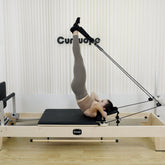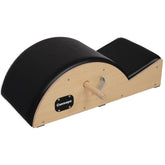Can Pilates Reformer help with back pain? Is it normal to feel sore after using a Pilates Reformer?
Can Pilates Reformer help with back pain?
The short answer is yes, Pilates Reformer can be an effective way to relieve back pain. The Reformer provides a low-impact workout that can help to strengthen the muscles in the back, hips, and abdomen, which are all important for supporting the spine. By improving strength and flexibility in these areas, the Reformer can help to alleviate back pain and reduce the risk of future injuries.
Pilates Reformer exercises can be effective in alleviating back pain by strengthening the muscles that support the spine, improving posture, and promoting flexibility. However, before starting any exercise program, it is important to consult with a healthcare professional to determine the underlying cause of your back pain and to determine whether Pilates Reformer exercises are appropriate for your condition.

How Pilates Reformer can help with back pain:
Improves posture: Poor posture can contribute to back pain by putting extra strain on the muscles and ligaments of the spine. Pilates Reformer workouts are designed to improve posture by strengthening the core muscles and promoting proper alignment of the spine.
Builds core strength: The core muscles, including the muscles of the abdomen and lower back, are essential for supporting the spine and maintaining proper posture. By targeting these muscles, the Reformer can help to improve core strength, which can reduce the risk of back pain.
Increases flexibility: Tight muscles can also contribute to back pain by limiting range of motion and putting extra strain on the back muscles. Pilates Reformer workouts focus on stretching and lengthening the muscles, which can improve flexibility and reduce back pain.
Provides low-impact exercise: High-impact exercises, such as running or jumping, can put extra stress on the joints and muscles of the back. Pilates Reformer workouts provide a low-impact alternative that can still provide a challenging workout while reducing the risk of injury.
Is it normal to feel sore after using a Pilates Reformer?
It is normal to feel sore after using a Pilates Reformer, especially if you are new to the practice or if you have not exercised in a while. The soreness is usually due to the muscles being worked in a new way and is a sign that the muscles are adapting to the exercise. The soreness should go away within a few days.
To minimize soreness, it is important to start slowly and gradually increase the intensity of the exercises over time. Proper form is also essential to prevent injury and reduce soreness. It is also important to stretch after exercising to prevent muscle stiffness and soreness.
Here are some things to keep in mind if you are feeling sore after a Pilates Reformer workout:
Give your muscles time to recover: Soreness is a sign that your muscles have been worked hard and need time to recover. It's important to give your muscles a chance to rest and recover between workouts. This can help to prevent injury and ensure that you continue to make progress over time.
Stay hydrated: Drinking plenty of water can help to flush out toxins that can contribute to soreness and inflammation. Aim to drink at least eight glasses of water a day, and more if you are working out intensely.
Stretch: Stretching can help to alleviate soreness and improve flexibility. Take some time to stretch after your Pilates Reformer workout, focusing on the muscles that feel the most sore.
Take it slow: If you are new to Pilates Reformer, it's important to take it slow and gradually increase the intensity of your workouts over time.
In summary, Pilates Reformer exercises can be effective in alleviating back pain by strengthening the muscles that support the spine, improving posture, promoting flexibility, and reducing stress. It is normal to feel sore after using a Pilates Reformer, but the soreness should go away within a few days. Gradually increasing the intensity of the exercises and practicing proper form can help prevent soreness and injury.





